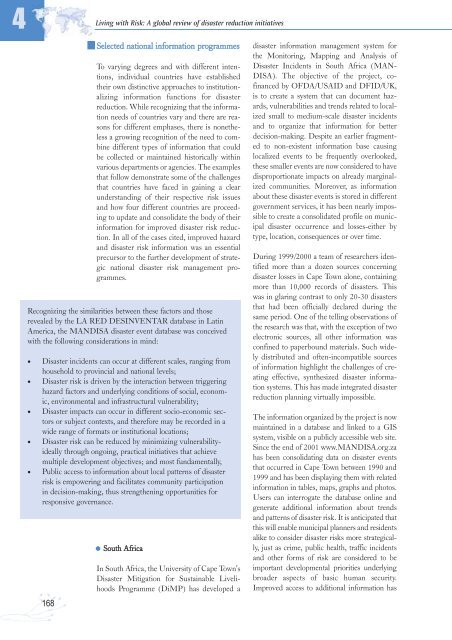A global review of disaster reduction initiatives - Welcome to the ...
A global review of disaster reduction initiatives - Welcome to the ...
A global review of disaster reduction initiatives - Welcome to the ...
Create successful ePaper yourself
Turn your PDF publications into a flip-book with our unique Google optimized e-Paper software.
4Living with Risk: A <strong>global</strong> <strong>review</strong> <strong>of</strong> <strong>disaster</strong> <strong>reduction</strong> <strong>initiatives</strong>168Selected national information programmesTo varying degrees and with different intentions,individual countries have established<strong>the</strong>ir own distinctive approaches <strong>to</strong> institutionalizinginformation functions for <strong>disaster</strong><strong>reduction</strong>. While recognizing that <strong>the</strong> informationneeds <strong>of</strong> countries vary and <strong>the</strong>re are reasonsfor different emphases, <strong>the</strong>re is none<strong>the</strong>lessa growing recognition <strong>of</strong> <strong>the</strong> need <strong>to</strong> combinedifferent types <strong>of</strong> information that couldbe collected or maintained his<strong>to</strong>rically withinvarious departments or agencies. The examplesthat follow demonstrate some <strong>of</strong> <strong>the</strong> challengesthat countries have faced in gaining a clearunderstanding <strong>of</strong> <strong>the</strong>ir respective risk issuesand how four different countries are proceeding<strong>to</strong> update and consolidate <strong>the</strong> body <strong>of</strong> <strong>the</strong>irinformation for improved <strong>disaster</strong> risk <strong>reduction</strong>.In all <strong>of</strong> <strong>the</strong> cases cited, improved hazardand <strong>disaster</strong> risk information was an essentialprecursor <strong>to</strong> <strong>the</strong> fur<strong>the</strong>r development <strong>of</strong> strategicnational <strong>disaster</strong> risk management programmes.Recognizing <strong>the</strong> similarities between <strong>the</strong>se fac<strong>to</strong>rs and thoserevealed by <strong>the</strong> LA RED DESINVENTAR database in LatinAmerica, <strong>the</strong> MANDISA <strong>disaster</strong> event database was conceivedwith <strong>the</strong> following considerations in mind:• Disaster incidents can occur at different scales, ranging fromhousehold <strong>to</strong> provincial and national levels;• Disaster risk is driven by <strong>the</strong> interaction between triggeringhazard fac<strong>to</strong>rs and underlying conditions <strong>of</strong> social, economic,environmental and infrastructural vulnerability;• Disaster impacts can occur in different socio-economic sec<strong>to</strong>rsor subject contexts, and <strong>the</strong>refore may be recorded in awide range <strong>of</strong> formats or institutional locations;• Disaster risk can be reduced by minimizing vulnerabilityideallythrough ongoing, practical <strong>initiatives</strong> that achievemultiple development objectives; and most fundamentally,• Public access <strong>to</strong> information about local patterns <strong>of</strong> <strong>disaster</strong>risk is empowering and facilitates community participationin decision-making, thus streng<strong>the</strong>ning opportunities forresponsive governance.South AfricaIn South Africa, <strong>the</strong> University <strong>of</strong> Cape Town'sDisaster Mitigation for Sustainable LivelihoodsProgramme (DiMP) has developed a<strong>disaster</strong> information management system for<strong>the</strong> Moni<strong>to</strong>ring, Mapping and Analysis <strong>of</strong>Disaster Incidents in South Africa (MAN-DISA). The objective <strong>of</strong> <strong>the</strong> project, c<strong>of</strong>inancedby OFDA/USAID and DFID/UK,is <strong>to</strong> create a system that can document hazards,vulnerabilities and trends related <strong>to</strong> localizedsmall <strong>to</strong> medium-scale <strong>disaster</strong> incidentsand <strong>to</strong> organize that information for betterdecision-making. Despite an earlier fragmented<strong>to</strong> non-existent information base causinglocalized events <strong>to</strong> be frequently overlooked,<strong>the</strong>se smaller events are now considered <strong>to</strong> havedisproportionate impacts on already marginalizedcommunities. Moreover, as informationabout <strong>the</strong>se <strong>disaster</strong> events is s<strong>to</strong>red in differentgovernment services, it has been nearly impossible<strong>to</strong> create a consolidated pr<strong>of</strong>ile on municipal<strong>disaster</strong> occurrence and losses-ei<strong>the</strong>r bytype, location, consequences or over time.During 1999/2000 a team <strong>of</strong> researchers identifiedmore than a dozen sources concerning<strong>disaster</strong> losses in Cape Town alone, containingmore than 10,000 records <strong>of</strong> <strong>disaster</strong>s. Thiswas in glaring contrast <strong>to</strong> only 20-30 <strong>disaster</strong>sthat had been <strong>of</strong>ficially declared during <strong>the</strong>same period. One <strong>of</strong> <strong>the</strong> telling observations <strong>of</strong><strong>the</strong> research was that, with <strong>the</strong> exception <strong>of</strong> twoelectronic sources, all o<strong>the</strong>r information wasconfined <strong>to</strong> paperbound materials. Such widelydistributed and <strong>of</strong>ten-incompatible sources<strong>of</strong> information highlight <strong>the</strong> challenges <strong>of</strong> creatingeffective, syn<strong>the</strong>sized <strong>disaster</strong> informationsystems. This has made integrated <strong>disaster</strong><strong>reduction</strong> planning virtually impossible.The information organized by <strong>the</strong> project is nowmaintained in a database and linked <strong>to</strong> a GISsystem, visible on a publicly accessible web site.Since <strong>the</strong> end <strong>of</strong> 2001 www.MANDISA.org.zahas been consolidating data on <strong>disaster</strong> eventsthat occurred in Cape Town between 1990 and1999 and has been displaying <strong>the</strong>m with relatedinformation in tables, maps, graphs and pho<strong>to</strong>s.Users can interrogate <strong>the</strong> database online andgenerate additional information about trendsand patterns <strong>of</strong> <strong>disaster</strong> risk. It is anticipated thatthis will enable municipal planners and residentsalike <strong>to</strong> consider <strong>disaster</strong> risks more strategically,just as crime, public health, traffic incidentsand o<strong>the</strong>r forms <strong>of</strong> risk are considered <strong>to</strong> beimportant developmental priorities underlyingbroader aspects <strong>of</strong> basic human security.Improved access <strong>to</strong> additional information has

















